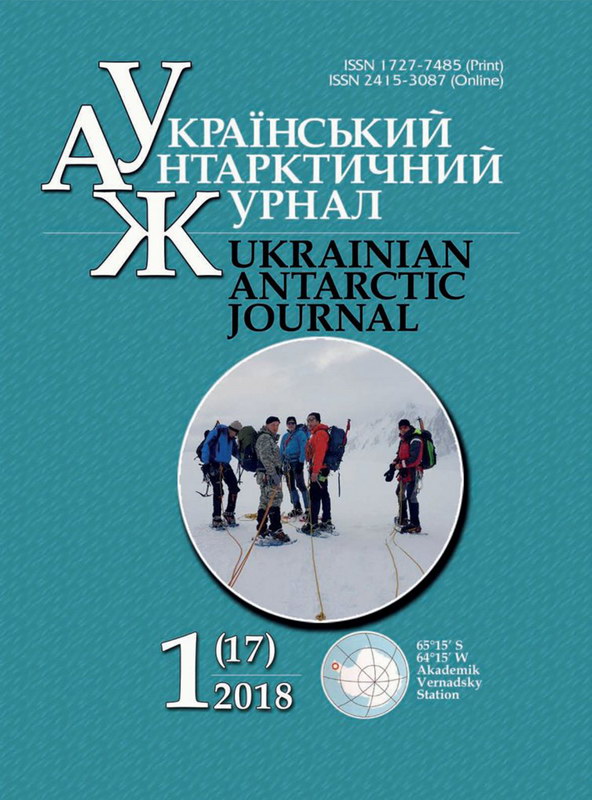Modeling Summer Circulation and Distribution of Temperature and Salinity in the Bellingshausen Sea and on the Antarctic Peninsula Shelf
- Bellingshausen Sea,
- Antarctic Peninsula,
- SCHISM model,
- cold intermediate layer

This work is licensed under a Creative Commons Attribution-NonCommercial-NoDerivatives 4.0 International License.
Abstract
The objective of the study is to simulate the summer circulation and the distribution of temperature and salinity in the Bellingshausen Sea and on the shelf of the Antarctic Peninsula. Numerical methods are used for simulation by means the SCHISM model with an unstructured triangular horizontal grid and a vertical local sigma coordinate system (LSC2). The k-kl model of turbulence was used to describe turbulence. Heat, momentum and salt fluxes were set on the ocean surface, which were calculated according to the ERA-Interim reanalysis. At open boundaries, the vertical distribution of temperature and salinity was determined according to the HYCOM reanalysis calculations. On the western open border, the level deviations and the vertical velocity distribution calculated by HYCOM were also specified. At the open eastern boundary of the computational domain, the radiation conditions were specified. The results of the HYCOM reanalysis were also used as initial conditions. The results of modelling the current, temperature, and salinity fields in the period February—March 2014 were compared with the available observational data on the shelf of the Antarctic Peninsula, including data from the Ukrainian Antarctic expedition. The calculated vertical distributions of temperature and salinity on the shelf are consistent with observations, in particular, in the position and magnitude of the minimum temperature of the cold intermediate layer and its temperature in the region of the Argentine Islands. Calculations have shown that the main component of the circulation is the Antarctic Circumpolar Current (ACC), which carries water to the east. In ACC, several jets are formed flowing into the Drake Strait, whereas a chain of vortices separates the shelf zone of the Antarctic Peninsula and the ACC. In the summer, a current directed southwards along the edge of the shelf, caused mainly by large-scale ocean circulation and the wind field. It was concluded that the formation of zones of upwelling and downwelling on the shelf of the Antarctic Peninsula substantially depends on the changes in the atmospheric circulation over the Bellingshausen Sea.
References
- Artamonov, Yu.V., Romanov, A., Vnukov, Yu., Perov, A., Stepura, I. 2003. Results of oceanographic studies in the western part of the Bransfield Strait in March 2002. Ukrainian Antarctic Journal, 1, 7-16. URL: http://dspace.nbuv.gov.ua/handle/123456789/128118.
- Artamonov, Yu.V., Romanov, A., Vnukov, Yu., Lomakin, P., Perov, A., Stepura, I. 2003. Features of the hydrological and hydrochemical structure of waters in the region of the archipelago of the Argentine Islands in February-March 2002. Ukrainian Antarctic Journal. 1, 17-24. URL: http://dspace.nbuv.gov.ua/handle/123456789/128119.
- Artamonov, Yu.V., Bulgakov, MP, Vashchenko, V.M., Lomakin, P.D. 2006. Oceanographic research of Ukraine in the Atlantic sector of the Antarctic (1997-2004). K: Naukova Dumka.
- Bulgakov, N.P. , Ukrainsky, V.V., Popov, Yu.I., Lomakin, P., Artamonov, Yu.V. 2001. Structure and kinematics of waters in the region of the Argentine Islands in the fall of 1998. Physical Oceanography, 11, 447-457. https://doi.org/10.1007/BF02509710
- Bulgakov, N. P., Lomakin, P. D., Artamonov, Yu. V., Kondrat'ev, S. I., Chepyzhenko, A. I. 2002. Water structure and kinematics in the region of the Argentine Islands archipelago in March-April 2000. Physical Oceanography. 12. 291-298. https://doi.org/10.1023/A:1021519026944
- Neverovsky, I.P., Popov, Yu.I., Sytov, V.N., Matygin, A.S. 2015. The first observation of a cold intermediate layer on the shelf of the Antarctic Peninsula. Ukrainian Antarctic Journal, 14, 114-123. URL: http://dspace.nbuv.gov.ua/handle/123456789/129688.
- Ukrainsky, V.V., Popov, Y.I., Neverovsky, I.P. and others. 2000. Characteristics of currents and the vertical structure of waters in the area of the islands of the Argentine archipelago according to field observations. Bul. UAC, 3, 102-110.
- Dinniman, M.S., Klinck, J.M., 2004. A model study of circulation and cross-shelf exchange on the west Antarctic Peninsula continental shelf. Deep-Sea Research, II. 51, 2003-2022. https://doi.org/10.1016/j.dsr2.2004.07.030
- European Centre for Medium-range Weather Forecast (ECMWF) 2011. The ERA-Interim reanalysis dataset, Copernicus Climate Change Service (C3S) https://www.ecmwf.int/en/ forecasts/datasets/archive-datasets/reanalysis-datasets/era-interim, (accessed: 10.02.2019).
- GEBCO, General Bathymetric Chart of the Oceans, 2019. The GEBCO_2014 Grid, version 20150318, www.gebco.net (accessed: 10.02.2019).
- HYCOM Ocean prediction system. 2019. http://hycom.org/ocean-prediction (accessed: 10.02.2019).
- Johannessen, O.M., Volkov V.A., Pettersson, L.M., Maderich, V.S., Zheleznyak, M.J., Gao, Y., Bobylev, L.P., Stepanov, A.V., Neelov, I.A., Tishkov, V. Nielsen, S.P. 2010. Radioactivity and Pollution in the Nordic Seas and Arctic Region. Observations, Modelling and Simulations. Springer. Series: Springer Praxis Books, P. 408.
- MERCATOR OCEAN, 2019. Ocean monitoring and forecasting. http://www.mercator-ocean.fr/eng (accessed:10.02.2019).
- Regan, H.C., Holland, P.R., Meredith, M. P., Pike, J. 2018. Sources, variability and fate of freshwater in the Bellingshausen Sea, Antarctica. Deep Sea Research Part I, 133, 59-71. https://doi.org/10.1016/j.dsr.2018.01.005
- Rintoul, S., Hughes, C., Olbers, D. 2000. The Antarctic Circumpolar Current system. Ocean Circulation and Climate, J. Church and J. Gould, Eds., Academic Press, 271-302. https://doi.org/10.1016/S0074-6142(01)80124-8
- Smith, D. A., Klinck, J. M. 2002. Water properties on the west Antarctic Peninsula continental shelf: A model study of effects of surface fluxes and sea ice. Deep-Sea Research, Part II ,49, 4863-4889. https://doi.org/10.1016/S0967-0645(02)00163-7
- Smith, D.A., Hoffmann, E.E., Klinck, J.M., Lascara, C.M..1999. Hydrography and circulation of the west Antarctic Peninsula continental shelf. Deep-Sea Research, Part I, 46, 951-984. https://doi.org/10.1016/S0967-0637(98)00103-4
- Zhang, Y. J., Ateljevich, E., Yu, H.-C., Wu, C.H., Yu, J.C.S. 2015. A new vertical coordinate system for a 3D unstructured-grid model. Ocean Modelling, 85, 16-31. https://doi.org/10.1016/j.ocemod.2014.10.003
- Zhang, Y. J., Stanev, E.V., Grashorn, S. 2016. Seamless cross-scale modelling with SCHISM. Ocean Modelling, 102, 64-81. https://doi.org/10.1016/j.ocemod.2016.05.002

